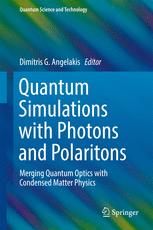

Most ebook files are in PDF format, so you can easily read them using various software such as Foxit Reader or directly on the Google Chrome browser.
Some ebook files are released by publishers in other formats such as .awz, .mobi, .epub, .fb2, etc. You may need to install specific software to read these formats on mobile/PC, such as Calibre.
Please read the tutorial at this link: https://ebookbell.com/faq
We offer FREE conversion to the popular formats you request; however, this may take some time. Therefore, right after payment, please email us, and we will try to provide the service as quickly as possible.
For some exceptional file formats or broken links (if any), please refrain from opening any disputes. Instead, email us first, and we will try to assist within a maximum of 6 hours.
EbookBell Team

4.3
18 reviewsThis book reviews progress towards quantum simulators based on photonic and hybrid light-matter systems, covering theoretical proposals and recent experimental work. Quantum simulators are specially designed quantum computers. Their main aim is to simulate and understand complex and inaccessible quantum many-body phenomena found or predicted in condensed matter physics, materials science and exotic quantum field theories. Applications will include the engineering of smart materials, robust optical or electronic circuits, deciphering quantum chemistry and even the design of drugs.
Technological developments in the fields of interfacing light and matter, especially in many-body quantum optics, have motivated recent proposals for quantum simulators based on strongly correlated photons and polaritons generated in hybrid light-matter systems. The latter have complementary strengths to cold atom and ion based simulators and they can probe for example out of equilibrium phenomena in a natural driven-dissipative setting. This book covers some of the most important works in this area reviewing the proposal for Mott transitions and Luttinger liquid physics with light, to simulating interacting relativistic theories, topological insulators and gauge field physics. The stage of the field now is at a point where on top of the numerous theory proposals; experiments are also reported.
Connecting to the theory proposals presented in the chapters, the main experimental quantum technology platforms developed from groups worldwide to realize photonic and polaritonic simulators in the laboratory are also discussed. These include coupled microwave resonator arrays in superconducting circuits, semiconductor based polariton systems, and integrated quantum photonic chips.
This is the first book dedicated to photonic approaches to quantum simulation, reviewing the fundamentals for the researcher new to the field, and providing a complete reference for the graduate student starting or already undergoing PhD studies in this area.